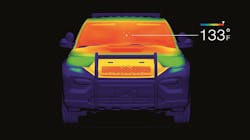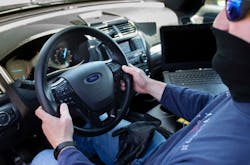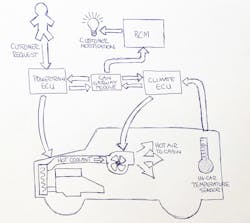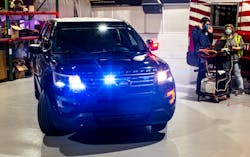Turning Up the Heat: How Ford’s New Software Update is Protecting Officers
A new software update released by the Ford Motor Company last year for its Police Interceptor vehicles aimed at reducing the risk of law enforcement officers or other vehicle occupants contracting COVID-19 will now come standard in all Police Interceptor Utility 2022 models.
According to Greg Ebel, Police Brand Marketing Manager for Ford Pro, after the COVID-19 pandemic began in early 2020, the company went right to the drawing board in search of viable solutions. “We wanted to do something to make the vehicles safer for officers out there on the front lines. Officers were sometimes transporting COVID patients to hospitals. It was a difficult time for all,” he says. “Our engineers went to the table and sketched out, ‘How can we make this work?’ ”
What followed was a heated sanitization solution that was designed as a direct response to problems created by COVID-19 and the pandemic. “It was a time when there was a quick response needed based upon customer feedback and how we could sanitize these vehicles.”How it works
The sanitization software uses the Police Interceptor’s own powertrain and climate control system. This software solution enables the vehicle to discharge air super-heated beyond 133 degrees Fahrenheit for 15 minutes into the passenger compartment. Ford worked with The Ohio State University to determine the temperature and time duration needed to help deactivate the COVID-19 virus and found that this combination reduces the viral concentration by greater than 99 percent on interior surfaces and materials used inside the vehicles.
Once the software is activated, the vehicle’s powertrain and climate control system work together. The software warms up the engine to an elevated level, and both heat and fan settings operate on high. The feature automatically monitors interior temperatures until the entire passenger compartment hits the optimal level, then that temperature is maintained for 15 minutes.
During the sanitization process, the hazard lights and taillights flash in a pre-set pattern to notify onlookers when the process has begun, and then will change at the end to signal completion. The vehicle’s instrument cluster also indicates progress. A cool-down process lowers the temperature from its highest points.
Using the software
The software update was initially rolled out as a service download with two activation methods. For the 2013 to 2019 models of the Police Interceptor, including the Sedan and Utility models, the user tool could be activated via the OBD2 port inside the vehicle. Some larger agencies had the necessary tool from Ford and could install the software themselves, but any agency could have it installed through their local Ford dealer. For the 2016 to 2022 models of the Police Interceptor Utility, the update is installed through a unique sequence of vehicle controls on the steering wheel. For the 2020 and 2021 models, there is a service download that has recently been released. For all new 2022 models, the update will come standard from the factory.
There is a certain process in place for fleet managers to follow, according to Ebel. “It’s not like there’s one button for heated sanitization where if you accidentally hit it with your elbow, it’s going to go off while you’re inside. It’s pretty particular with a unique sequence and it’s not going to be accidentally activated. You have to activate it and get outside the vehicle.
“It’s an easy process and quite frankly, it’s the right thing to do. The officers, and all law enforcement personnel for that matter, are constantly on the front lines and are subjected to COVID and other viruses in the vehicle. They really appreciate the fact that we went to work immediately during a very tough time, not only for us as a company, but for the country and the world.”Positive feedback
Cpl. J.M. Short, fleet manager of the 55-member Waynesboro Police Department in Virginia, says the new software has been a game changer. Just recently, officers transported a woman to a local hospital where she tested positive for COVID-19. “I get a call at two o’clock in the morning and say ‘OK, what car?’ I go down there and turn it on. By the end of my time, the car was ready to be put back into service right away.”
Previously, the department would have had to call in a company each time to spray the entire car with a mist and then use ions to get it out of the HVAC vents. Each time the Waynesboro Police Department had to call the company, it would cost $30 per car. “Doing this saves us hundreds if not thousands of dollars,” says Short. “As for time, before if a vehicle was down at 10 at night, it wouldn’t be back up until I got a hold of the guy the next day. The car could be out of service from 12 to 16 hours.”
With the new software update, Short says that if an officer calls in that their vehicle has been contaminated, he can run the system and in a little over an hour have the unit back in service.While officers must wipe down the inside of their patrol vehicles after transporting a subject, the new software update has helped add another level of protection. Short says that now, if an officer transports someone who is repeatedly coughing or says that they have COVID, officers can report it and the software could be activated after the officer and the subject exit the vehicle. “I highly recommend that you use this software,” he says. “To save my officers from being sick, it’s a must.”
Ford has begun a 17-city national Police Tour (fordpolicetour.com), and Ebel says all of the feedback he’s heard on the sanitization software has been positive. “We’ve been getting great feedback from customers on the tour saying ‘Hey, we’re using the heated sanitization solution in our vehicles. It’s such a great way to keep our officers safer as we move forward.’ It makes their jobs easier too so they don’t have to go in after their shift with a rag and a spray bottle to try to disinfect as well as they can. This is a very effective solution, and it utilizes the software and the components that are already in the vehicle. It’s been great leading up to this since we launched this for 2022 and we’re starting to get this news out there while interacting with our customers on the tour.”
Ebel says that with the Delta variant to worry about and a rise in hospitalizations, the country is still not out of the woods. “Now that we’re making it easier on all 2022 model year Police Interceptor Utilities to have this standard from the factory, it just helps agencies out moving forward.”
About the Author
Paul Peluso
Editor
Paul Peluso is the Managing Editor of OFFICER Magazine and has been with the Officer Media Group since 2006. He began as an Associate Editor, writing and editing content for Officer.com. Previously, Paul worked as a reporter for several newspapers in the suburbs of Baltimore, MD.




